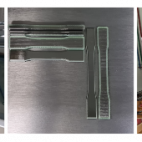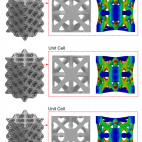Samantha Carolina Mora Hidalgo, Ph.D. Candidate 35th cycle, University of Trento, DICAM
The nature’s concepts to reach high strength or energy absorption by means of a precise material distribution only where it is really necessary, have been a constant research target for decades [1][2]. Examples of cellular structures such as bones, teeth, honeycombs, or nacre, have served as inspiration to study and fabricate architected materials. They present a complex and detailed structural geometry [3], whose manufacturing can be possible by recent advances in 3D printing technology, reaching a micro-scale and the use of different base materials. As a starting point, the latest works in 3D printed architected lattices, with a special focus in Polyjet technique were analyzed. Thereby, it was identified that nowadays, there is a low number of studies related to the fabrication of 3D printed architected materials that also include an accurate mechanical characterization that considers manufacturing effects.
Our intended fabrication of high-performance micro-lattice materials, aims to obtain high mechanical properties such as strength and stiffness, besides the improvement of buckling and post-buckling resistance, at the lightest density values possible. Even lower than the density of its solid counterpart and trying to cover the suggested gaps in Ashby materials charts. Stretch dominated lattices, whose struts present variable internal radii, were 3D modelled parametrically as a base configuration for the respective numerical simulations, as it can be seen in Figure 1. At the same time, the material characterization of the photopolymer resins for Polyjet technique was done by tensile tests under ASTM D638 procedures. Different printing orientations in the samples, shown in Figure 2, were considered to determine the present anisotropy caused by the process, as well as several materials such as rigid, flexible and the combination of both (Digital Materials).
The next steps are oriented to the optimization of the lattices by increasing their compressive, buckling and post-buckling resistance with the lowest density, in function of varying the struts’ radii and material, adding an analytical and experimental validation. Furthermore, tests related to the inclusion viscoelastic inputs, such as relaxation time modulus, are intended to perform an accurate characterization of the photopolymers and their respective material constitutive model. Then, the obtained outcomes will be able to be extended to custom lattice typologies (i.eg. Functionally graded density or hierarchical lattices).
Bibliography
[1] L. Gibson and M. Ashby, Cellular solids. Structure and properties, Second. Cambridge Solid State Science Series, 1997.
[2] S. Vogel, “Better Bent Than Broken,” 1995. [Online]. Available: https://www.discovermagazine.com/the-sciences/better-bent-than-broken.
[3] L. Valdevit, K. Bertoldi, J. Guest, and C. Spadaccini, “ARCHITECTED MATERIALS : SYNTHESIS , CHARACTERIZATION , MODELING , AND OPTIMAL DESIGN,” Mater. Res., vol. 33, no. 3, pp. 241–246, 2018.
Update 2022
The nature’s concepts of achieving high strength or energy absorption by a precise material distribution, have been a constant research target for decades [1][2]. Examples of cellular structures such as bones, teeth, honeycombs, or nacre, have served as inspiration to study and fabricate architected materials. They present a complex and detailed structural geometry [3], whose manufacturing can be possible by recent advances in 3D printing technology, in a wide scale range and by using different base materials. As a starting point, the latest works in 3D printed lattices with a special focus in Polyjet technique were analyzed. Thereby, it was identified that there are still few of these structures designed and fabricated including manufacturing effects.
Moreover, the very well-known concept of Origami emerges as a promising alternative to obtain compliant and at the same time, resistant deployable structures. It makes possible to envision a counter-intuitive bellow mechanism along cylinders, by keeping the initial cross section while it is under axial loading. For this reason, the aim of this work is to merge the origami mechanical capabilities with stretch dominated 3D lattice structures (e.g., octet truss) to improve their strength, stiffness, as well as energy absorption at the lowest density values possible.
The initial part of this work, consists in the 3D parametric modelling and analysis of cylinders with multi-stable Kresling origami patterns [4]. The materials considered for their fabrication and prior numerical simulations, were flexible + rigid resins (digital materials) for the folding creases and rigid photopolymers for the panels. The main goal is to assess diverse origami cylinder configurations in order to maintaining the high resistance and lightweight design philosophy. At the same time, the initial material characterization of the used photocurable resins was done by tensile tests, under ASTM D638 procedures. Different printing orientations in the samples, shown in Figure 1, were considered to include the effects of the anisotropy caused during the process.
Based on the outcomes of the proposed multi-material Kresling origami tubes, 3D lattices were fabricated, as seen in Figure 2. Then, they will be subjected to compression tests in order to validate experimentally the obtained designs. The expected results aim to find lattices with a higher buckling resistance, compressive strength and energy absorption than traditional stretch dominated structures. Indeed, more controlled buckling shapes and less strain concentrations along the struts. Further dynamic and fatigue experimental work is also expected.
Bibliography
[1] L. Gibson and M. Ashby, Cellular solids. Structure and properties, Second. Cambridge Solid State Science Series, 1997.
[2] S. Vogel, “Better Bent Than Broken,” 1995. [Online]. Available:
https://www.discovermagazine.com/the-sciences/better-bent-than-broken.
[3] L. Valdevit, K. Bertoldi, J. Guest, and C. Spadaccini, “ARCHITECTED MATERIALS : SYNTHESIS , CHARACTERIZATION , MODELING , AND OPTIMAL DESIGN,” Mater. Res., vol. 33, no. 3, pp. 241–246, 2018.
[4] B. Kresling, “Natural Twist Buckling in Shells: From the Hawkmoth’s Bellows to the Deployable Kresling-Pattern and Cylindrical Miuraori,” Proc. 6th Int. Conf. Comput. Shell Spat. Struct., no. May, pp. 1–4, 2008.


